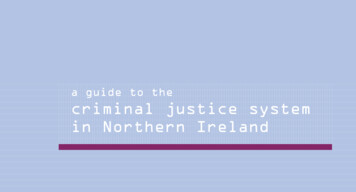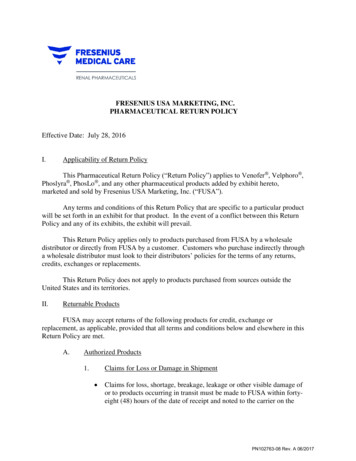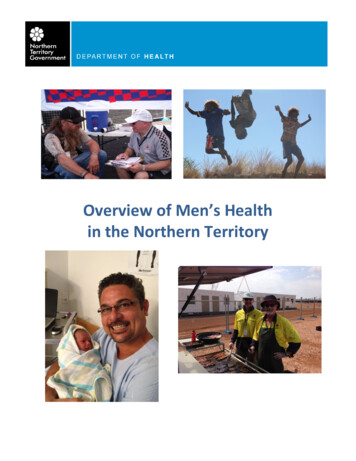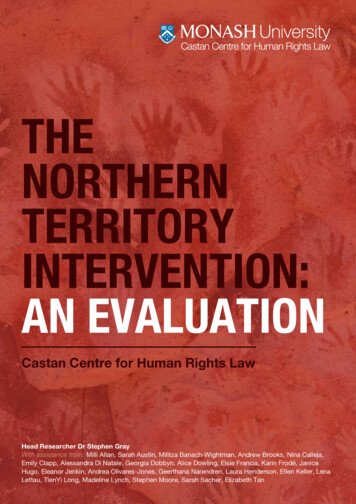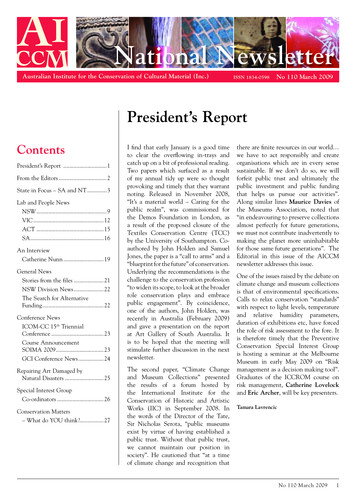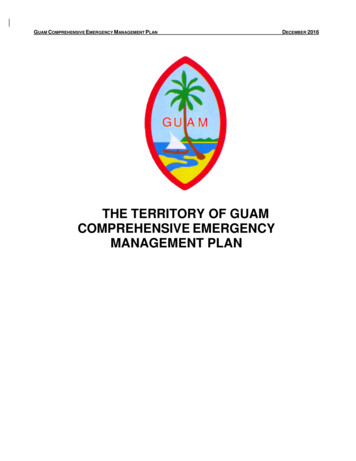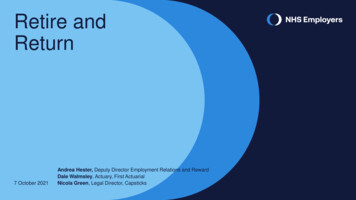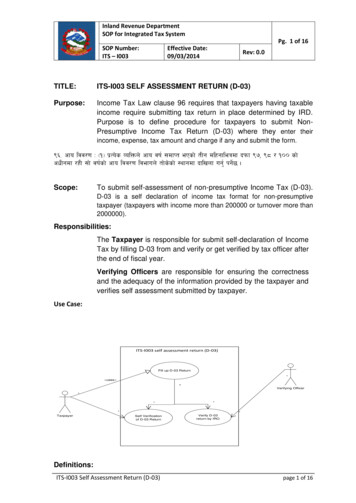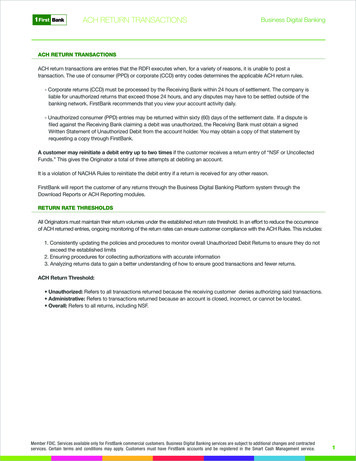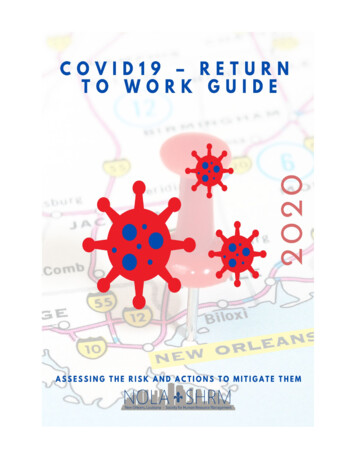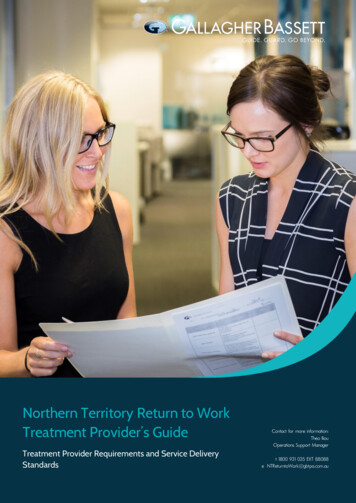
Transcription
Northern Territory Return to WorkTreatment Provider’s GuideTreatment Provider Requirements and Service DeliveryStandardsContact for more information:Theo IliouOperations Support Managert 1800 931 035 EXT 88088e NTReturntoWork@gbtpa.com.au
IntroductionIntroduction to the Northern Territory workers compensation scheme and the evidence for recovery atworkTreatment providers play an important role in the Northern Territory workers compensation system. You are engaged toprovide expertise in the development of an evidenced based treatment and rehabilitation strategy for workers who havesustained an injury at work.The purpose of this guide is to help you understand what to do and what to expect when delivering services for a worker’scompensation claim managed by Gallagher Bassett in the Northern Territory. It outlines your obligations under workerscompensation legislation, and provides practical advice to help get the best outcome for the worker.This guide is based on the large body of evidence about the health benefits of work and the Clinical Framework for theDelivery of Health Services which was developed by Transport Accident Commission and WorkSafe Victoria and issupported by NT WorkSafe as well as numerous peak allied health bodies including the Australian Physiotherapy Associationand the Australian Psychological Society.Workers Compensation in the Northern TerritoryThe Northern Territory workers compensation system operates under the Return to Work Act 2016 (2016 Act) andassociated Regulations. The system provides no-fault protection to workers and their employers following a work relatedillness or injury.There are two types of insurers in the Northern Territory workers compensation system, approved insurers and approvedself-insurers. The Northern Government is the largest employer with the Territory and is an approved self-insurer. GallagherBassett is appointed to manage workers’ compensation claims on behalf of the Northern Territory Government.The evidence for recovery at workThe evidence for recovering at work shows:1.For most people with a work related injury, time off work is not medically necessary2. An unnecessary delay in returning to work is often associated with delayed recovery – the longer a worker is awayfrom work, the less chance they have of ever returning3. Staying active after an injury reduces pain symptoms and helps workers return to their usual activities both athome and at work sooner4.Working helps workers stay active which is an important element of their treatment.Gallagher Bassett 1
Clinical Framework for Service DeliveryThe clinical framework outlines a set of guiding principles for the delivery of rehabilitation, medical, surgicaland other treatmentThe Clinical Framework principles were established to encourage participation of the injured worker at home, at work andwithin the community in order to achieve the best possible outcome. Gallagher Bassett’s expectations of providers whenmanaging injured workers is to ensure their recovery is goal orientated, evidence based and clinically justified. Theseprinciples are also designed to support you in your treatment of an injury and aid in dispute resolution through:1.Measurement and demonstration of the effectiveness of treatment2. Adoption of a biopsychosocial approach3. Empowering the injured person to manage their injury4.Implementing goals focused on optimising function, participation and return to work5. Base treatment on best available research evidence.Principle 1: Measure and demonstrate effectiveness of treatment1.Treatment should result in a measurable benefit to the injured person2. Relevant aspects of the person’s health status that are expected to change with treatment should be measured(such as pain, depression, activities of daily living, health-related quality of life and work performance)3. When available, outcome measures that are reliable, valid and sensitive to change should be used4.Outcome measures must be related to the functional goals of therapy, relevant to the person’s injury, and addressthe components of the world health organisation international classification of functioning, disability and health.Principle 2: Adopt a biopsychosocial approach1.Healthcare professionals must consider the biological, psychological and social factors that influence a person’shealth as part of their assessment and treatment interventions2. A biopsychosocial approach improves function, facilitates recovery and maximises independence, while minimisingthe risk of long-term activity limitation, participation restriction, or persistent pain3. The early identification and management of risk factors helps to address issues that can impact on an optimaloutcome.Gallagher Bassett 2
Principle 3: Empowering the injured person to manage their injury1.Empowering the injured person to manage their injury is a key treatment strategy and should be incorporated in allphases of injury management2. The main ways to empower an injured person are education, setting expectations, developing self-managementstrategies and promoting independence from treatment3. Healthcare professionals need to empower an injured person to actively participate in activities at home, work andin the community as part of their rehabilitation.Principle 4: Implementing goals focused on optimising function, participation and return to work1.Goals should be developed in collaboration with, and agreed to by, the injured person2. Goals should be functional and smart – specific, measurable, achievable, relevant and timed3. Progress towards goal achievement should be regularly assessed and goals reset or modified as necessary.Principle 5: base treatment on best available research evidence1.Healthcare professionals need to use the best available research evidence to inform their decision making2. Systematic reviews provide the most comprehensive and unbiased source of research evidence3. A high quality, randomised, controlled trial is the strongest research design for evaluating treatment efficacy4.Treatments with good evidence for efficacy are preferred over other treatments5. Where there is good evidence that treatment lacks efficacy, it should not be used.Gallagher Bassett 3
Provider Management PlansThe process for developing and monitoring of Provider Management Plans for the treatment of workersThe Provider Manager Plan (PMP) is the primary communication tool regarding the worker’s recovery and the provision ofservices. It facilitates communication between all stakeholders to ensure appropriate, cost effective treatment is provided tothe worker with the best possible outcome.The PMP allows you to: Describe the impact of the injury on the worker in terms of reported and observed signs and symptoms, as wellas their capacity to engage in their roles at work, home and the community Set smart goals and empower the worker to be actively involved in their recovery Outline an action plan, listing actions the worker and you are individually responsible for Demonstrate the effectiveness of treatment using measurable outcomes Request approval of treatment services, including equipment needs and case conferencing, using a rationale tosupport the services requested Indicate the anticipated timeframe the recovery will take Receive an insurer decision to your request.The PMP is required to be submitted following the initial consultation with the injured worker and prior to the fourth sessionbeing completed. As part of a single PMP you can request up to eight treatment services, although only the number oftreatment sessions that are reasonably necessary should be requested. The PMP is available to download from our websiteon ntg.gallagherbassett.com.auA PMP is required for all allied health and rehabilitation services. Prior approval for the initial consultation is required exceptfor physiotherapists, osteopaths and psychologists.Gallagher Bassett 4
Reasonable and necessary treatmentBefore approving or paying for a medical, hospital or rehabilitation treatment or service, Gallagher Bassett will determine,based on the facts of each case, that the treatment or service: is reasonably necessary, and is required as a result of the work related injury/illnessWhen considering the facts of the case, Gallagher Bassett will consider: what is determined as reasonably necessary for one worker may not be reasonably necessary for another workerwith a similar injury reasonably necessary does not mean absolutely necessary although evidence may show that a similar outcome could be achieved by an alternative treatment, it does notmean that the treatment recommended is not reasonably necessaryIn most cases the above points should be sufficient for Gallagher Bassett to determine what is reasonably necessary. Whereit remains unclear on whether a treatment is reasonably necessary, then the following factors may be considered: The appropriateness of the particular treatment The availability of alternative treatment The cost of the treatment The actual or potential effectiveness of the treatment The acceptance of the treatment by medical expertsProviders should be able to provide justification that their treatment is reasonably necessary. A medical referral alone is notsufficient to meet the ‘reasonably necessary’ benchmark.Within seven days of receiving the PMP, Gallagher Bassett will approve in whole or part, decline or request furtherinformation if the information provided was insufficient.Where a request for further information is not responded to satisfactorily within fourteen days, Gallagher Bassett may askfor a second opinion.The second opinion will be requested from an independent peer review of allied health treatment, and may: Work with the treatment provider to decide what future treatment content and duration will achieve the bestoutcomes for the worker and increase their capacity for employmentGallagher Bassett 5
Advise the worker, provider and Gallagher Bassett on the ongoing need for further treatmentA second opinion may also be requested by Gallagher Bassett when treatment extends beyond two PMPs, or ifafter discussion with the treating provider there is concern about: The treatment duration, frequency and/or whether treatment is reasonably necessary Treatment that has continued for an extended period without any improvement in functional outcomes, particularlyin relation to a worker’s capacity The treatment approach most likely to achieve positive work outcomes for the worker Barriers to recovery at work and/or psychosocial risk factors for delayed recovery and work loss.The second opinion will not determine causation or liability, or undertake any formal functional capacity evaluationor assessment for the purposes of assessing capacity for work.Gallagher Bassett may also refer for an Independent Medical Examination (IME). A referral to an IME may occurwhen medical information is inadequate, unavailable or inconsistent and Gallagher Bassett has been unable toresolve this with the practitioner directly. This may include advice on accepting a claim, ongoing liability, theworker’s level of capacity for employment, ongoing treatment and the degree of permanent impairment (whereapplicable).Conflict of interestProviders need to consider conflict of interest when providing services. A conflict of interest is a situation where aprovider could be influenced (or seen to be influenced) by a personal interest in carrying out their duties.This could occur if the provider has competing professional and personal interests that make it difficult for themto fulfil their duties impartially, or improperly influence the performance of their professional duties.Any provider who has a real, perceived or potential conflict of interest in undertaking their duties must declarethis conflict to Gallagher Bassett prior to the delivery of any service. These declarations will be assessed byGallagher Bassett on a case-by-case basis.When you receive a referralPlease contact Gallagher Bassett prior to your first appointment with the worker to confirm the following:1.2.Their claim has been acceptedthe worker is eligible for payment of medical and related expenses3. Gallagher Bassett agrees treatment is reasonably necessary.Gallagher Bassett 6
Change in worker circumstancesCircumstances concerning worker eligibility for medical and related expenses may change for a number ofreasons.Treatment may have been approved but then, due to circumstances changing with the claim status, treatmentfunding is no longer available. This may occur because: The worker’s claim has been declined or settled Gallagher Bassett has obtained information and we have determined treatment is no longer reasonably necessary Time limit thresholds have been metAllied health practitioners should clarify eligibility prior to their initial consultation with the worker, resumption oftreatment, or where they believe other circumstances have changed which may impact the worker’s eligibility tomedical and related expenses.Service provider feesAs outlined in this document Gallagher Bassett will pay reasonable treatment costs associated with treatment approved inPMPs, or treatment that was approved prior to being provided (those costs being not more than the relevant amount setout in any guidelines published by NT Worksafe).All invoices must be itemised and include the following; The words ‘Tax Invoice’ stated prominently The name of the individual practitioner who provided the service Location details of where the treatment was delivered The date the tax invoice was issued The provider’s Australian Business Number (ABN) The worker’s name and claim number Date of each service Appropriate NT worksafe workers compensation payment classification code and the cost for each service Payee EFT and email address detailsGallagher Bassett 7
Where services were not approved in the PMP, or prior to being provided Gallagher Bassett reserves the right to refusepayment. Gallagher Bassett will contact the provider to advise of this decision. Gallagher Bassett may also contact providerswhere service provision anomalies appear to have occurred.Gallagher Bassett 8
gallagherbassett.com.augallagherbassett.co.nzAbout Gallagher Bassett:Managing claims is all we do and we do it with singular focus and passion. Drawing on our global network and extensive local resources, Gallagher Bassett providescustomized claim and mitigation solutions that improve our clients’ outcomes.Our story is one of innovation, commitment to quality and strategic decision making.GB introduced the Third Party Claims Administrator (TPA) model to the local insurance industry. As pioneers in this fast growing sector, we continue to set the benchmarkfor quality, customer service and TPA systems across all insurance sectors.Globally, we are the largest property/casualty TPA, with operations in the United States, Canada, the United Kingdom, Australia and New Zealand.With offices in Melbourne, Brisbane, Adelaide, Sydney and New Zealand, and a team of more than 900 claims management experts, GB provides a unique suite of claimsmanagement and related consulting and technical services.Being part of a global organisation gives us an advantage in technology, processes, personnel and consulting services. Our highly-regarded myGB client benefits programprovides powerful tools and benefits that ensure clients receive a personal, valuable and user-friendly solution.This combination of global reach and local market expertise enables us to quickly and accurately assess any situation and provide an optimal solution. Our clients can restassured that their TPA fully understands their needs and is equipped to act whenever, wherever and however required.
Gallagher Bassett on a case-by-case basis. When you receive a referral Please contact Gallagher Bassett prior to your first appointment with the worker to confirm the following: 1. Their claim has been accepted 2. the worker is eligible for payment of medical and related expenses 3. Gallagher Bassett agrees treatment is reasonably necessary.
